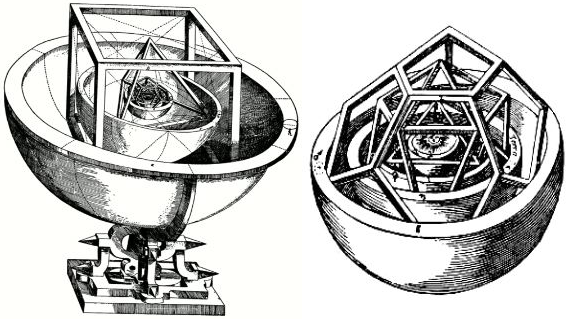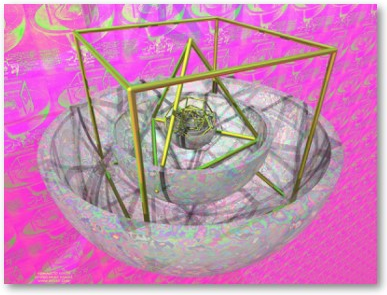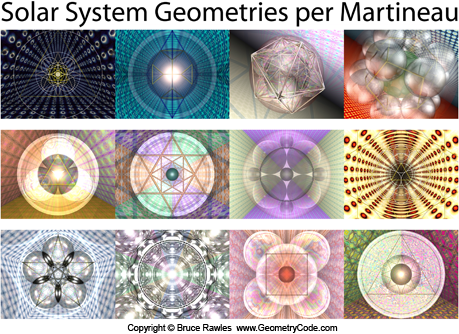The folks at Ka Gold Jewelry continue to add exquisite new artistic creations to their extensive line of geometrically inspired, mystical, cosmic jewelry. Check out these new items which include a vesica-piscis-yin-yang-entangled pendant, star tetrahedra with and without enclosing spheres, Flower of Life, Seed of Life, zodiacal emblems and even a truncated icosahedron (i.e. soccer ball shape) where each face is a seed of life shape … and much more, drawing from a diversity of cultural traditions and contemporary visionary interpretations! Neat! … and you might also want to take advantage their current seasonal 15% discount; use Coupon Code – KAGOLD2014 which is valid until December 24, 2014. Enjoy!
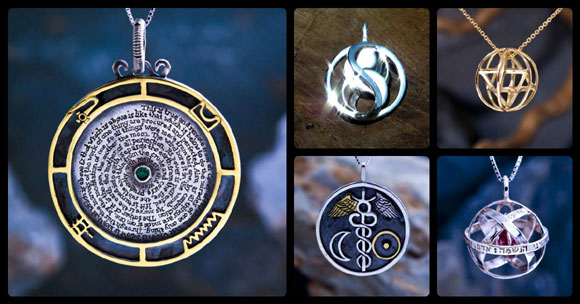
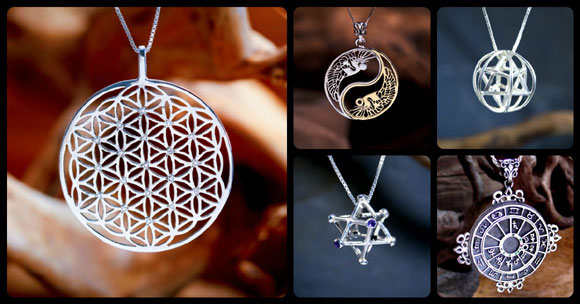
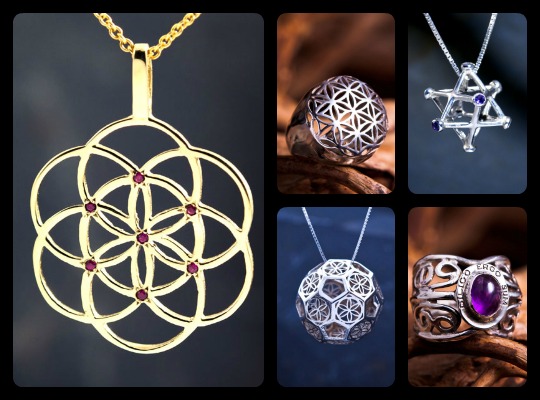
Search Results for: vesica
Sacred Geometry interview with CA Brooks
CA Brooks, who hosts the “Simple Tales” show on 12Radio, interviewed me on August 26, 2014. We talked about the origins and history of sacred geometry in art, architecture and nature, the 5 Platonic Solids, dimensions, volcanos, symbols, the Great Pyramid at Giza, Egypt, the seven Hermetic Laws of antiquity, golden rectangles, golden triangles, spirals, the vesica piscis, and much more. This show was evidently selected as the “Producer’s Choice of the Week”; what fun! Enjoy! :-)
I also was on CA’s other show (about A Course In Miracles) on Aug. 22, 2014; more details and the audio archive for that interview here.
GeometryCode bulletin for April 2014
(1) News, Events, Interviews, Workshops, Classes, Exhibits, Products, Articles, Tutorials
Martineau Solar System Geometries art exhibit in Castle Rock, CO
An exhibit of all 12 of my “Martineau Solar System” series framed giclées prints, plus 24 framed acrylic, collage and mixed media art images by Nancy Bolton-Rawles are now on display between May 7 and June 16, 2014 at the Philip S. Miller Public Library, 100 S. Wilcox St., Castle Rock, Colorado 80104 during regular library hours. This is the first public exhibit for either of us since we moved to Colorado almost 3 years ago… You can find upcoming, ongoing and past exhibits, classes and other events here. Enjoy! :-)
About the Martineau Solar System Geometries art and the Astronomical Geometry It Is Based On
The 12 images were inspired by the remarkable work of John Martineau, in his highly recommended book: “A Little Book of Coincidence.” The accuracy of his models is truly astonishing, typically 99.8 to 99.9% accurate. Johannes Kepler, who was fascinated with the idea of simple geometric models defining the planetary orbits, was on the right track, he just didn’t explore far enough… His original woodcuts appear below, showing the outer and inner solar system. He would have been thrilled to learn of Martineau’s models! I think John Martineau’s name will (some day, hopefully soon) be heralded among Kepler, Galileo, Newton and Einstein for the astronomical discoveries he’s made.
Here’s my image paying homage to Kepler’s elegant, though not particularly accurate models of the solar system.
All images in my “Martineau Solar System” series were created with the freeware ray tracing application, POV-Ray; I’ve been using MegaPOV more recently. Here is an online gallery of this art (available as posters, greeting cards or apparel), plus other related images & photography.
More details about the individual images in the Martineau Solar System Geometries art exhibit
Here are early studies (sans NASA or other photographic tiled imagery for the background) for both the inner and outer solar system models, respectively, that John Martineau figured out; note that these highly accurate geometric approximations to planetary orbits averaged as circles (instead of the ellipses they actually are) were accomplished using only 2-dimensional geometric models, and rather simple ones at that! :-)
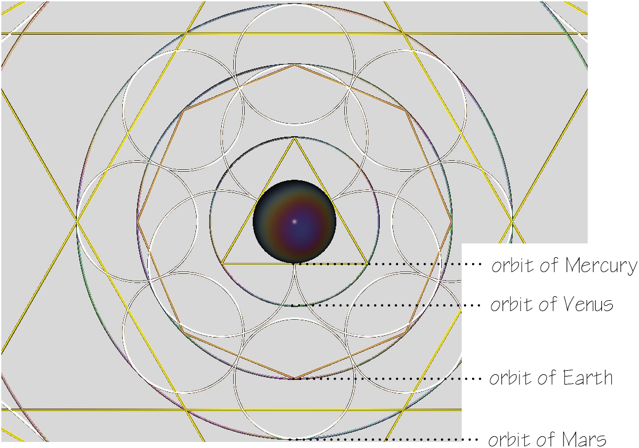
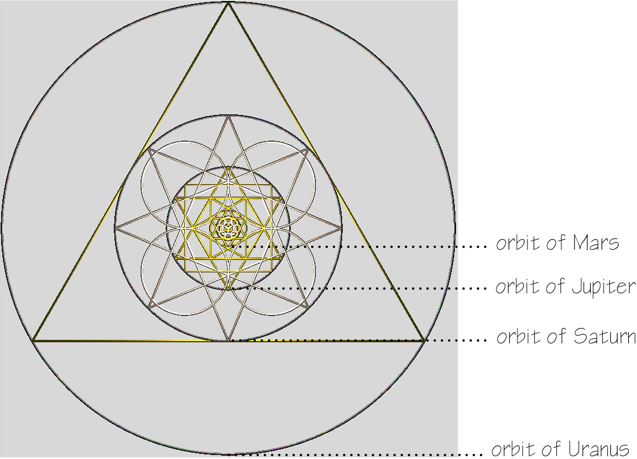
Outer Solar System: Solar System to Uranus Per Martineau
The background image for this foreground montage of John Martineau’s geometric solar system models is a tiled Kirlian photography image of fingertip corona discharge patterns that I took decades ago using a homebrew adaptation of a kit from Edmund Scientific Company.
Inner Solar System: Solar System to Mars Per Martineau
The background image for this closeup foreground montage of John Martineau’s geometric solar system models is a tiled color-inverted version of the Kirlian photography image used in the Outer Solar System model; the intent being to depict the warmer colors as a metaphor for the proximity to our sun.
Venus And Mars Per Martineau
With tiled planes of solar and lunar motifs in the background, a dodecahedron (12 pentagons, Plato’s symbol for ether or spirit) defines 20 spheres (the metallic looking ones) that exactly touch. Inside these are the orbit of Venus (green) and outside all is the orbit of Mars (faint red). The accuracy of the model (averaging the major and minor axes of the elliptical orbits) is 99.98%
Earth And Mars Per Martineau
With tiled planes of flora (a Hawaiian plant swirled within a honeycomb grid) and fauna (Chambered Nautilus) motifs in the background, an icosahedron (20 triangles, Plato’s symbol for water) defines 12 spheres that exactly touch. The centers of these define the orbit of Earth (blue) and outside all is the orbit of Mars (red). The accuracy of the model (averaging the major and minor axes of the elliptical orbits) is 99.9%
Earth And Venus Per Martineau
This image was inspired by the remarkable work of John Martineau, in A Little Book of Coincidence. Five tiled spiral galactic (NGC300) planes form the background. The perigee and apogee relationship between Earth and Venus is described by a nested pentagram pair. Accuracy is 99.9%
Venus and Earth Orbits Per Martineau
The orbital relationship between Earth and Venus is described by two concentric circles. The inner circle represents the orbit of Venus which passes through the centers of 8 circles that just touch each other. The outer circle represents the orbit of Earth which touches the outer sides of these 8 circles. The accuracy of this relationship is 99.99%
Earth and Mars Cross Per Martineau
This image was inspired by the illustration at the bottom of page 40 of the remarkable work of John Martineau, in A Little Book of Coincidence. A circle (Earth orbit) just touches each of 4 small circles, which in turn, each just touch 4 larger circles, which each touch the largest outer circle (Mars orbit). Spheres are used to represent the circles for artistic effect, and the outermost eight spheres are decorative only. The accuracy of this relationship is 99.9%
Venus And Mercury Per Martineau
Tiled, mirrored images of Mercury’s surface features (colorized three different ways) form the background. Three circles, whose centers are the vertices of an equilateral triangle, define an outer circle which exactly fits around the three (the orbit of Venus) and an inner circle which exactly touches the three vertices (the orbit of Mercury). Accuracy is 99.9%
Jupiter And Mars Per Martineau
This image was inspired by the remarkable work of John Martineau, in A Little Book of Coincidence. Tiled planes of Jupiters surface (top & bottom) and a colorized map of Mars sketched by the astronomer Antoniadi (left & right) form the background. The centers of four circles define the orbit of Jupiter and the orbit of Mars is defined by the red circle. The accuracy of this relationship is 99.99%
Jupiter, Saturn And Uranus Per Martineau
This image was inspired by the remarkable work of John Martineau, in A Little Book of Coincidence. Tiled, mirrored images of Saturns rings (colorized three different ways) form the background. Three concentric circles, define the orbits of Jupiter, Saturn and Uranus. The innermost (Jupiter) touches 8 middle points of an octagram. The outermost octagram points define Saturns orbit. The circle around an equilateral triangle around Saturn defines Uranus. The accuracy of the Jupiter/Saturn relationship is 99.9%
Jupiter And Earth Per Martineau
This image was inspired by the remarkable work of John Martineau, in A Little Book of Coincidence. Tiled colorized planes of the Great Red Spot of Jupiter (shifted +/- 120 degrees of hue, too!) form the background. The hexagon within a triple nested hexagram defines the orbit of Earth. The orbit of Jupiter is defined by the outer circle, and astonishingly, two clusters of asteroids (the Trojans) occupy Laplace Points, which are also defined by the + and – 60 degree positions in Jupiters orbit as shown on the diagram below. Accuracy of the Earth/Jupiter orbital relationship is 99.8%
Neptune And Uranus Per Martineau
This image was inspired by the remarkable work of John Martineau, after he wrote A Little Book of Coincidence (hence the model does not appear in that book.) Tiled images of Neptune’s surface line the union of two vesical tubes to form the background. A tetrahedron and its truncation define the orbits of Neptune and Uranus, respectively, with 99.93% accuracy. Here’s an early study (sans NASA tiled imagery for the background):
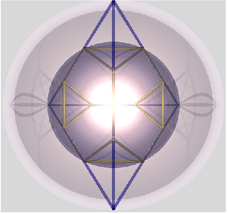
(2) Websites, Books, Videos, Imagery, Music and Quotes
Here are a couple of geometric websites this month, with lots of interesting content for geometry enthusiasts:
(3) Request for Submissions
Facebook, YouTube, Twitter, Pinterest and LinkedIn. I always enjoy connecting with both recent and long-time friends and colleagues and discovering new friends of friends :-)Thanks for your interest & support! :-) BTW, I always appreciate enthusiastic reviews on the Amazon SGDS book page, and the newer Amazon book page for The Geometry Code. It’s a good “win-win” way to cross-promote your work as well.
If you like to color with colored pencils (or other media), make 3-D fold-up geometric art, do stained glass, quilts, geometric arts and/or crafts, or just want an extensive reference/resource of geometric archetypes, patterns and essential line art, you might enjoy a copy of my first book, Sacred Geometry Design Sourcebook: Universal Dimensional Patterns.
If your leanings are more metaphysical … and perhaps whimsical :-) … you might enjoy my second book, The Geometry Code: Universal Symbolic Mirrors of Natural Laws Within Us; Friendly Reminders of Inclusion to Forgive the Dreamer of Separation. It was originally going to have geometry and Hermetic Laws/symbolism as a primary focus, but in 2007, a reawakened interest in the spiritual masterpiece, A Course In Miracles – thanks to Gary Renard – shifted the primary emphasis to an exploration of the two thought fundamental systems we all vacillate between, and how we can gradually shift our mind’s identity to the happy one.
PO Box 192, Castle Rock, Colorado 80104
author of The Geometry Code book; co-author of The Geometry Code screensaver
author of Sacred Geometry Design Sourcebook
Free monthly email bulletin on sacred geometry and related subjects
You might also enjoy my blog which has lots of other fun and info in addition to these bulletins.
GeometryCode bulletin for January 2014
(1) News, Events, Interviews, Workshops, Classes, Exhibits, Products, Articles, Tutorials

Sacred Geometry Fest – New York City; April 4-13, 2014
The Academy of Sacred Geometry is offering a Sacred Geometry Fest in NY, NY April 4-13, 2014. The list of faculty and presenters includes Scott Olsen, Robert Lawlor (from Australia in a rare presentation), Mark Hanf, Steve Bass, Dorthea Rockburne, Frank Vedegys, Lance Harding Ph.D, John Lloyd and Karl Lorenzen. Also featuring via webinar link up from France, Dan Winter and Bill Donavan. Details here. … I wish I could attend! (I have other commitments.) If anyone who IS planning to attend would like to submit a review of the event, or other details of interest to all of us who study sacred geometry, please contact me. Here is more info about Academy of Sacred Geometry and it’s founder, Roger Green.
Metaphysics and sacred geometry interview by David Whitehead
Here is a recent (recorded 30Dec2013) interview of Bruce Rawles by David Whitehead on his Truth Warrior program; we talked about sacred geometry, Hermetic laws, and – of course! – non-dual metaphysics; all topics I enjoy sharing.
Artistic Interpretation of the Science of Cymatics
Geometer colleagues Jeff Volk and Mandara Cromwell, along with dancer Kate Holland will be giving an Artistic Interpretation of the Science of Cymatics Feb. 4 and 5 in San Diego and Santa Monica, California, respectively. Here’s an excerpt from their program notes for the event:
“Throughout all the cultures of the world, as far back as history recalls‒sound, song and sacred movement have played pivotal roles in focusing attention and bringing awareness back to the essential nature of our being. Modern science can now show us precisely how this occurs, right down to the biochemical reactions and our corresponding neurological responses. The mechanisms through which this takes place are the underlying principles of resonance and entrainment. The science of Cymatics brings these principles to life, vividly showing how audible sound can animate inert powders, pastes and liquids, into coherent forms that appear like living, breathing organisms‒shedding light on the mysteries of manifestation and allowing us to see this primordial creative force in action!
In this highly engaging program, world-class presenters weave together the arts‒poetry, music, and sacred dance‒with the science of sound, offering a visceral understanding of how our world is composed and of our seminal role in that dynamic, creative process. This is something that must be experienced to be fully understood, yet once we’ve had this experience, even in a limited way, our way of viewing ourselves‒and our creative potential‒is forever changed.”
Quantum physics proves that death is an illusion
Here’s a neat, short article that employs quantum physics to challenge the dominance of space and time over mind; author Prof. Robert Lanza suggests that “space and time are simply tools of our mind.”
Astronomical Geometry Calendars for 2014
The images above are colorized versions of 12 of the exquisite images in John Martineau’s “Little Book of Coincidence”, depicting the exquisite planetary mathematics exhibited in the orbital relationships of our solar system’s planets from Mercury to Neptune. Martineau’s astonishingly accurate 3-D models of our solar system inspired the calendar above, freshly updated for 2014… Here’s where you can learn more and order a copy of this astronomically astounding calendar, with the price reduced from last year as well.
(2) Websites, Books, Videos, Imagery, Music and Quotes
Here are a few websites and links of interest to sacred geometry enthusiasts:
- The geometric image below is from a recent bulletin from long-time geomancer, Sig Lonegren from his Mid-Atlantic Geomancy site; the illustration by dowser Dan Mattson shows vesica piscis geometries of the Anundshög site in central Sweden.
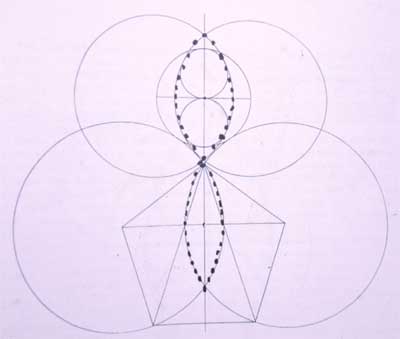
(3) Request for Submissions
Facebook, YouTube, Twitter, Pinterest and LinkedIn. I always enjoy connecting with both recent and long-time friends and colleagues and discovering new friends of friends :-)Thanks for your interest & support! :-) BTW, I always appreciate enthusiastic reviews on the Amazon SGDS book page, and the newer Amazon book page for The Geometry Code. It’s a good “win-win” way to cross-promote your work as well.
If you like to color with colored pencils (or other media), make 3-D fold-up geometric art, do stained glass, quilts, geometric arts and/or crafts, or just want an extensive reference/resource of geometric archetypes, patterns and essential line art, you might enjoy a copy of my first book, Sacred Geometry Design Sourcebook: Universal Dimensional Patterns.
If your leanings are more metaphysical … and perhaps whimsical :-) … you might enjoy my second book, The Geometry Code: Universal Symbolic Mirrors of Natural Laws Within Us; Friendly Reminders of Inclusion to Forgive the Dreamer of Separation. It was originally going to have geometry and Hermetic Laws/symbolism as a primary focus, but in 2007, a reawakened interest in the spiritual masterpiece, A Course In Miracles – thanks to Gary Renard – shifted the primary emphasis to an exploration of the two thought fundamental systems we all vacillate between, and how we can gradually shift our mind’s identity to the happy one.
PO Box 192, Castle Rock, Colorado 80104
author of The Geometry Code book; co-author of The Geometry Code screensaver
author of Sacred Geometry Design Sourcebook
Free monthly email bulletin on sacred geometry and related subjects
You might also enjoy my blog which has lots of other fun and info in addition to these bulletins.
The Geometry Code: Universal Symbolic Mirrors of Natural Laws Within Us; Friendly Reminders of Inclusion to Forgive the Dreamer of Separation
Five Reasons to read the new book “The Geometry Code: Universal Symbolic Mirrors of Natural Laws Within Us; Friendly Reminders of Inclusion to Forgive the Dreamer of Separation” by Bruce Rawles
- To read a book inspired by the Hermetic philosophy classic about universal laws “The Kybalion” (published over 100 years ago)
- To deepen one’s understanding about the mystical mirroring aspects of all form, going beyond – yet including – sacred geometry, and reaching into the realms of pure non-dual metaphysics
- To see how modern quantum physics, ancient wisdom traditions and everything in between all point to the importance of choosing an all-inclusive thought system that embraces all symbols from life and welcomes a transpersonal, liberating interpretation
- To complement other ACIM studies for avid students of A Course In Miracles
- To enjoy a light-hearted look at how being kind and including All in our definition and identity of Self helps us find and sustain the unchanging peace that nothing in the world can touch.
An overview of The Geometry Code book
An Inclusive Identity transforms our experience from separate to whole. Our inner teacher of kindness reinterprets everyday events in ways that lead us to freedom. Observing our minds with this guidance, we apply universal laws to our individual lives, using geometric metaphors as memory aids, releasing the identification with unconscious victim scripts that sabotage our happiness. This book integrates practical insights from modern physics, ancient Hermetic Laws, non-dual metaphysics, transpersonal psychology – and humor – as tools for undoing conflicting beliefs we’ve dreamed ourselves into. Symbols remind us to forgive the dreamer.
We explore seven laws in-depth and demonstrate how a mindfulness that embraces ‘other’ as ‘self’ can reverse the typical misapplication of these inescapable laws of Mentalism, Correspondence, Vibration, Polarity, Rhythm, Cause & Effect, and Generation. Ubiquitous geometric symbols, paired to each of these laws – the circle, vesica piscis, sine wave, line, spiral, fractal, and yin-yang – and their countless commonplace variations, seen from the vantage point of shared interests, reflect these ideas. The inspired use of natural law restores attributes of life, love, strength, purity, beauty, perfection, and gratitude to our awareness. Our intentions of loving-kindness make use of these memory aids for returning our minds to wholeness as we forgive ourselves, using dreams to heal instead of harm.
Who The Geometry Code book was written for
This book bridges the gap between sacred geometry and non-dual metaphysics, going from manifestation (a.k.a. effect) back to cause (our mind, the basis for any metaphysical system worth it’s ‘meta’ 
Having said all that, I imagine there are plenty of you (like me) who ARE interested in both sacred geometry AND metaphysics (which is why I put the Metaphysics category, plus Psychology, Philosophy, Spirituality, Symbolism, and Self-Help on the top of the back cover. 

